BMW i8 Concept
It’s been nearly two years since BMW’s Vision EfficientDynamics concept debuted at the 2009 Frankfurt show, and the car has now officially re-emerged one step closer to production as the BMW i8 concept. As you can see, little has changed in the styling department. In fact, other than a new wheel design, the only other notable change we’ve spotted concerns the doors, which seem to have claimed some territory along their bottoms and thereby reduced the size of the blue body-side accent. Interestingly, the car didn’t show that change when BMW paraded it around for spy photographers this past March, but we like it.
Passenger Compartment + Powertrain = LifeDrive
As with the i3 city car concept that debuted at the same time (you can read about it in full here), the story of the i8 begins with its so-called LifeDrive architecture. BMW says that its experiences in creating the Mini E and 1-series-based BMW ActiveE showed that adapting cars engineered for internal-combustion power to electric propulsion results in a lot of excess weight and compromises in packaging. As a result, both the i8 and i3 are built using two purpose-built modules: one to house passengers, dubbed “Life,” and one for propulsion and suspension components, called “Drive.” Combine them, and you have a car—and marketing-friendly “LifeDrive” branding.
While the i3 and i8 share the LifeDrive architectural philosophy, the cars differ in execution. That’s because the i3 is fully electric, while this i8 is a plug-in hybrid. The i8’s powertrain is split between its two axles, with an electric motor and direct-drive transmission at the front axle and a gas engine and transaxle at the rear.
Interestingly, the battery packs in the i3 and i8 use different lithium-ion chemistries, as well as unique shapes. The large, square pancake battery of the i3 is designed for longer distance travel—in other words, it has a lot of energy—and is located below the passenger compartment. In contrast, the i8’s lithium-ion cells protrude into the coupe’s Life space, where, as in the Chevrolet Volt, the liquid-cooled and -heated battery stack fills a hump that could be mistaken for a transmission tunnel. The i8’s elongated pack is designed to deliver shots of power in short spurts; the final spec is yet to be decided, but it should have a capacity of around 8 kWh.
So much lightweight material allows the i8 to use a smaller, lighter battery than would be needed if the car were made of heavier steel. This frees up room in the cabin, and, more important, keeps the curb weight around a svelte 3300 pounds. The rigidity imparted by the carbon fiber also allows for long, dramatic doors that ease access to the two small rear seats.
While most other hybrids are based on existing front-drive vehicles, BMW had the luxury of starting from scratch. As with all 50/50-balanced cars, the majority of braking forces occur at the front axle. So, in the effort to recoup as much energy from regenerative braking, it makes sense for BMW to fit the electric half of the powertrain up front. The i8 uses a modified version of the i3's electric motor, with a peak output of 129 hp and 184 lb-ft of torque. It’s fed juice, of course, by those lithium-ions, and takes about two hours to charge from a 240-volt trough. Battery topped off, the i8 will return 20 miles of all-electric driving.
Three’s Company: 220-Horse Three-Cylinder
The original Vision EfficientDynamics concept used a three-cylinder turbo-diesel engine, but the i8 makes use of a gas-fired turbo three-cylinder that may turn out to be the best part of the powertrain puzzle. It is a version of BMW’s new modular engine on which we first reported in April. It displaces just 1.5 liters, features direct injection, a turbocharger, variable camshaft timing, and variable intake-cam lift. It makes an astonishing 220 hp and 221 lb-ft of torque. Altogether, the hybrid powertrain makes 349 hp and 406 lb-ft of torque. That puts this car in elite company within BMW. Think M company.
The i8 weighs slightly less than a 1-series M, and makes more power and torque. BMW says the i8 is governed to 155 mph and it will accelerate from 0 to 60 mph in less than five seconds; think more like low fours with a quarter-mile time of less than 13 seconds. But where the 1M gets, at best, 26 mpg on the highway, BMW says the ocho should return real-world, combined fuel economy near 40 mpg. One area of concern for twisty-road seekers is its tires. They are narrow, of the low-rolling-resistance variety and will thus suffer in limit grip. We hope there’s an option box for summer tires.
Like the Porsche 918 supercar, the i8’s engine and electric motor can each power the car on their own or they can work in tandem for better traction at launch or when powering out of a tight corner. Each axle also contributes regenerative electricity; the front houses the regenerative braking system, while the engine at the rear has a high-voltage alternator—it looks to be about half the size of the inline-three’s block—to recapture energy. No mention was made regarding what type of transmission will be paired with the gas engine, but Bimmer reps said it is an automatic and a familiar piece. Our hunch is that it could actually be an unfamiliar six- or seven-speed dual-clutch automatic, although it might be the Mini Cooper’s six-speed slushbox tuned for efficient, low-rpm torque-convertor lockups.
A button-activated “Eco Pro” mode dulls throttle response and reduces the climate-control systems draw on the battery system. This improves fuel economy and has the potential to stretch the electric-only range a bit.
What i Looks Like
While not much has changed about the i8’s styling, a few themes have emerged now that it has a sibling in the i3. The laying of light-gray panels over a black and clear sub-layer is meant to reference the car’s Life and Drive components. Many of those clear layers, like the lower half of the swing-wing doors, will turn opaque when production time comes. Besides just looking flat-out futuristic, BMW i models will be marked by a BMW roundel with a blue ring around the outside, blue accents on the grilles and side sills, and the “stream flow” C-pillar treatment.Inside, the i8 concept foregoes traditional gauges in exchange for a more future-tech 8.8-inch display screen for reporting road and engine speed, as well as battery and fuel levels. In Eco Pro mode, the digital gauges glow blue; in Sport mode—details of which were in short supply—they glow orange. A second screen tops the dash above the center stack to display navigation and infotainment functions, and the rest of the interior is clean, simple, and made largely of recycled or sustainable materials.
Yes, the i8 is technically a concept, although in typical BMW fashion, it’s pretty well fleshed out and likely very close to what you’ll see when the production car launches in 2014. While the diminutive i3 is certainly intended to capture the attention of the general public, the i8 appears to be an effort to draw a few enthusiasts under the BMW i umbrella as sustainability and efficiency become increasingly important. While it remains to be seen if the i8 will be satisfying to pilot, we applaud the idea, since there’s not much that we want to see more than a long future for
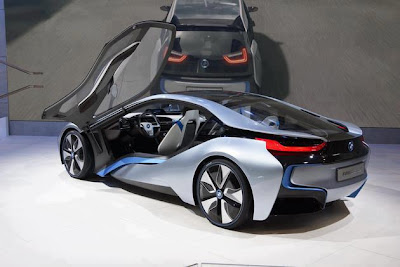
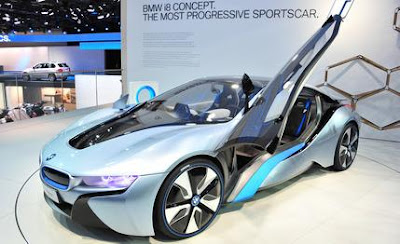
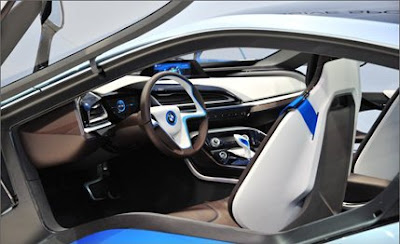


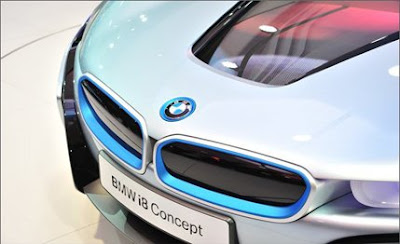

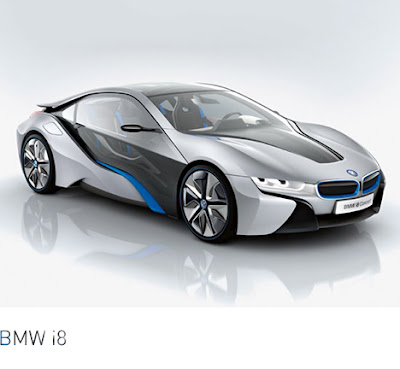
No comments:
Post a Comment